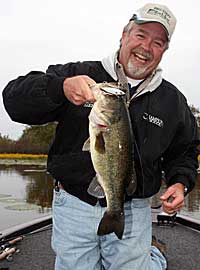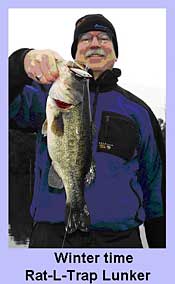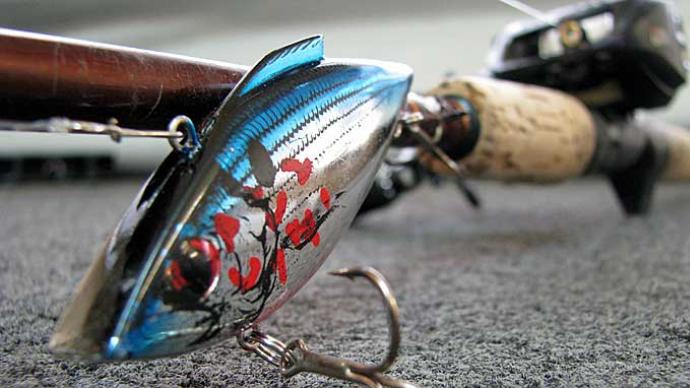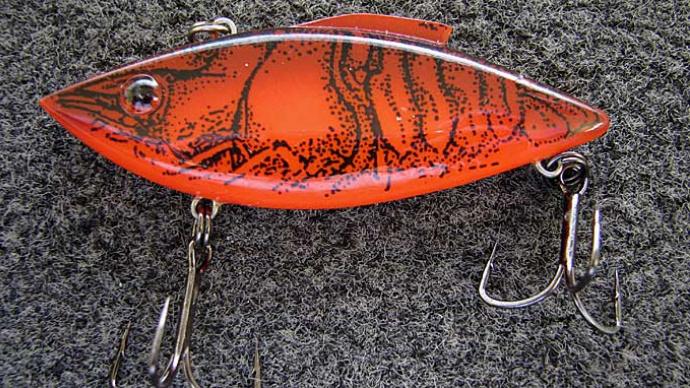
Mike Siefert, an expert Arkansas guide, was sharing in PART I where big fish hung out on Lake Millwood, and how stealth and technique specifics were important in fishing “the jungle” - an intimidating minefield of stumps and broken trees, surrounded by endless acres of aquatic hydrilla, coontail, pond weed, lily pads, and alligator weeds. An expert with lipless crankbaits, (and a diehard “Rat-L-Trap” fan), he continued to explain some of the finer points of “Trappin” Bass In The Jungle…
HOOK SETS
After beginning clients learn to cast the Rat-L-Trap, (throwing repeatedly beyond the timber, retrieving at different speed and depths), they inevitably encounter a strike. Should the angler set the hook when the strike comes? Mike responds, “The fish pretty much will set the hooks themselves. And you will know when he hits it, because if you’re not holding on to your rod, a lot of times he’ll slam it so hard, he’ll try to jerk the rod out of your hand. In fact, that’s happened more than once to some of my clients.”
Unlike the anglers who have to use a solid, perhaps even violent hookset to drive the hook through a thick piece of plastic in order to pierce the fish’s mouth; anglers throwing Rat-L-Traps need to know that the bass pretty much hook themselves - 9 out of 10 times, says Mike. He advises beginners just to tighten the line, and play him in.
THE FIGHT

Do inexperienced anglers tend to try and cross the fish’s eyes on the hook set? Mike quickly replies, “Not really, no… My experience has been that once the fish hits the bait and begins swimming, fighting, and pulling, the beginners know it’s on. All they want to do is wind them up. Beginners generally don’t know anything about hard hooksets.” He admits that it’s the experienced plastic fishermen that tend to make that mistake.
However some of the mistakes beginning clients do tend to make is “…horsing them too hard when it’s a big fish, so as to pull the hooks out of his mouth. Or... by not ‘leading’ the bass away from cover and vegetation, and allowing them to wrap themselves up in hydrilla or lily pad stems and breaking off. Or... they’ve got the fish hooked in the top of his head – because sometimes large fish run at the Trap and just slap at it. We’ve caught many fish that were hooked on the outside of their gill plates, or the top of their head.”
Why would large bass slap at the Rat-L-Bait instead of consuming it? Mike believes it is just trying to chase it off because often they’re not in a full-blown feeding mode and that noisy bait is irritating them because it has entered into their private domain. “Bass are very curious predators as well as territorial,” says Mike, “especially big bass.”
TERRITORIALITY
Siefert shared his understanding of bass territoriality. “If you catch an 8-pound bass off one piece of structure or cover, and you put it in your livewell, or transport it to your private pond, or zip it down the lake to a weigh-in that’s 10 miles away; 90% of the time there will be another big bass pull right back to that same spot and take his place within 12 hours.”
“That big fish is there for a reason,” says Mike. “He wasn’t there by accident, he is there because it offers him everything he needs: protection and plenty of oxygen, it offers him cover, and access to deep water, and has plenty of available forage without having to travel or swim a great distance to get it. Big bass are basically lethargic and lazy most of their lives; couch potatoes. Because of their lack of “exercise”, (expending as little energy as possible), they grow larger. Ideal locations, promoting their increased size, makes them dominant over the food chain and the top predator in the neighborhood. That’s why that trophy was where you caught it.”
And that’s why the big bass chases off the little guys. “Bass are very territorial. Once they’ve found a spot like that, (where they’ve got all their needs tended to), they will defend that location until a bigger bass comes along and runs them off.”
“Say you catch an 8 pounder off a particular stump in the river behind a creek mouth junction or a point. This spot may be in 6 foot of water with a laydown; an old dead tree lying right beside it. Here the fish had cover, food, and current that’s bringing it fresh water and oxygen. It had access to deep water – everything a big bass needed to survive. And that’s the only thing fish are concerned about is surviving and eating, (unless it’s spawning season. They’re just blinded by spawning).”
“So now that the 8 pounder has been removed, a 2 pounder may come along and say ‘Man, this looks like a good place to take a break.’ And it may stop and sit there, backed up underneath that log next to the stump. Then along comes a 3 or 4½ pounder, and it sees the same spot. And He says ‘Man this looks like a nice spot. I’ve got current bringing me bait and fresh oxygen. There’s plankton here on the side of this dead log that the shad and bluegill are feeding on. I’ve got access to the deep sanctuary of the river right here, which is just 20 foot over yonder. And it is six foot right here; it’s a comfortable temperature. I can breathe easy. It’s even got shade over my head. I could back right under that log right there and just wait for something to come swimming by. Man this looks like a good spot to set up camp!”
“Soon that 3 or 4 pounder will pull up in there, see that 2 pounder, and soon they’ll go to wrestling and fighting until the big one runs the little guy off. Two or three hours later, a 4½ or 5-pound bass may come by there, and the territorial conflict continues, and continues, until the biggest bass ends up dominating that spot.” And that trophy bass will often chase off even noisy baits like the angler’s Rat-L-Trap. “Unless it crushes em!” winks Siefert.
HOOKS
A fish accidentally hooked in the head or gills often occurs when a fish was simply intending to chase off the invading bait from its lair, …or is following your retrieved Trap watching and thinking about eating it, when suddenly you pause your retrieve, and the bass runs right into the bait. Still, hooking fish externally won’t occur with dull hooks. “Only the sharpest hook will ‘foul-hook’ a bass”, says Siefert, “and one foul-hooked bass in the head or gill plate, is one more bass in the boat, no matter how you look at it.”
“Until a few years ago, the first thing I did when I got a bunch of Rat-L-Traps (or most any lipped crankbait for that matter) was to take the factory hooks off and put chemically sharpened, after-market, treble hooks on. You want a sticky sharp hook on any crankbait, lipped or lipless, for the aforementioned reasons.” But according to Siefert, the Rat-L-Trap Company listened carefully to the pro-staff team and worked to improve the factory-installed hook’s quality.”
“Thus, we started experimenting with various, new treble hooks. That was two to three years ago, and if you go to Bass Pro Shops, Cabella’s, Gander Mountain, Academy, or Sports Authority or any of the retailers selling Rat-L-Traps, right now to buy any of these new Traps, you’ll see that the hook has been changed from the old-style silver hook. We’ve gone to using Mustad Triple-Grip hooks. It’s got a wide gap bend with an extremely sticky, dangerously sharp point and barb. All the new baits have got the new hooks on them. So that challenge has been resolved at Rat-L-Trap.”
“Here’s a slick secret or two: depending on my location on the lake and the presentation I am using at the time, I will occasionally put a smaller hook on the rear than the front, to reduce drag and allow more ‘tail kick’ than everyone else is throwing. This totally changes the action, sound, and motion, of my Trap with the smaller tail hook and it “kicks” harder and more violently with less drag on the tail. Sometimes I will remove the rear hook altogether, for a variety of different presentations, or replace it with a gold willow leaf or other blade, based on water conditions.”
TESTING SHARPNESS
No treble hook will remain sharp forever, and Mike is adamant about testing their points. “You need to check them periodically. To test a treble hook’s sharpness and points while it's still attached to the bait, I rest one of the barbs on my thumbnail with my thumb 180 degrees in a flat vertical plane. If you can lift your thumb to an angle between 20 to 40 degrees and the bait stays there, then I know that hook is sharp enough. Obviously you can do the same with the fleshy side of your thumb, but the point is going to stick in flesh a whole lot easier than in your thumb nail. But if the hook will stick to your thumbnail, it’ll definitely stick in a bass’ jaw.”
WHEN HUNGRY FISH STRIKE
A bass rarely misses a Rat-L-Trap when it is hungry. Most experts agree that an angler cannot crank a bait fast enough to pull it away from a bass that decides to consume it. And they do so with amazing accuracy. Siefert agrees. Almost 75% of the bass he catches is caught solidly on the front treble hook, indicating they consume hardbaits with ease when they want it.
Mike explains, “The bass will either hit the Rat-L-Trap 1) head-on by intercepting the Trap when they hear the vibrations getting louder in their direction, or 2) sideways, or 3) they’ll come up behind it and just flare their gills. Like a vacuum cleaner, they can suck the whole bait into their mouth. Do you know that a Largemouth bass, (5 pounds or bigger), can suck a plastic worm, jig, or motionless target into its mouth at a distance of 20 inches, while it is sitting on the bottom of the lake?” Naturally, sucking in a moving lipless crankbait is not a problem for a large bass. They can move large volumes of water when flaring their gills.
SPEED OF RETRIEVE
Chances are high that the average angler has at some time watched professional tournament fishermen on television “speed-reeling” a hardbait across the top of underwater grass fields or mud flats; typically using a lipless crankbait as a search tool to find active fish. Therefore, the majority of weekend anglers have adopted a “faster-the-better” approach. Fishing with his Dad on Millwood since age 6, Mike Siefert’s four decades of experience has convinced him that most anglers need to readjust their thinking, especially when it comes to hunting trophy fish.
“I’ve learned over the last 40 years – that the slower you will wind a lipless crankbait, the bigger the fish you will catch. A large bass, (and when we say large - we’re talking over 6 or 7 pounds), didn’t get that big by doing dumb stuff. They don’t just react to everything that comes by in front of them. Their brain may not be the size of your little fingernail, but they learn through their experiences in life what hurts and what doesn’t hurt, and what gets them in trouble and what doesn’t get them in trouble. And trophy fish are slightly more selective about how they react, how quickly they react, and what they react to.”
“No doubt, you will occasionally catch a trophy fish speed-reeling, but that’s more an exception than the rule. Speed-reeling is primarily a search tool. Once a pro angler catches one or two keeper fish within the slot limit, or within the size category of fish their looking for - you’ll notice they will often lay that crankbait down and go to a jig or a worm and make a lot slower methodical presentation to pick up bigger fish.”
Mike seemed to be implying, that if an angler were to stay with a Rat-L-Trap but slow down their presentation, they might also accomplish the same thing. Is that right? “No question about it!” declares our guide. “I couldn’t tell you the hundreds I’ve caught on Rat-L-Traps over 8 pounds doing just that.”
How slow can you go with a Rat-L-Trap? Is the idea to wind the crank as slow as you possibly can without hanging up? And as if to say “read my lips” Mike declares, “You can’t fish a Rat-L-Trap too slow!” Then Siefert makes a statement that makes even old-timers sit up and pay attention: “I have actually fished a Rat-L-Trap like a worm.”
SHOCKINGLY SLOW PRESENTATION
When not with clients, Mike has no hesitation performing one of the most eyebrow lifting presentations; one rarely associated with Rat-L-Traps. When fishing the old submerged, timber-lined river banks, parallel to the weed lines, and either inside or outside the tree or stump-line, he casts then retrieves extremely slow. How slow?
“I’ll throw a Rat-L-Trap and fish it like a worm. A lot of times I’ll take the rear hook off and just fish with the front hook. I’ll let the Rat-L-Trap go all the way to the bottom. And I’ll just pop my rod tip maybe 6 or 12 inches, and make it jump up and fall right back down. It is easy pickings for the bass, and hard for them to resist the repeated “in your face” imitation of a dying or injured prey. This approach works especially well with Rat-L-Trap’s crawfish patterns but also very well with the shad and/or bream patterns too.”

While others are ‘speed-reeling’ their lipless cranks, Mike is slowly jumping and hopping it along the bottom like a worm. “99 percent of folks won’t do it, because you do tend to get hung up a lot. But patience is a virtue and it pays off with big dividends and big bass. A lot of people say ‘I can’t fish that Rat-L-Trap – I get hung up every time’. And I say ‘Ya know, I’ve been fishin a Rat-L-Trap over 30 years and I still get hung up. But you know what? If you’re not getting hung up, you’re not fishing in the right place.’”
“I carry a telescopic lure retriever with me and I’ll try to get the bait loose. Extending to 16 or 18 feet, that lure retriever returns my crankbaits 90% of the time. And on those rare occasions when I can’t free with the pole, I’ll just pull on the line until the lure comes off, straightens the hook, or breaks off. In the later case, I’ll tie on another one and continue fishing the same way. Why? Because I know that hopping a Trap like a worm is a big fish technique.”
“Now that’s not to say I won’t fish a Rat-L-Trap fast. If I pull up onto a flat parallel to a creek channel and the water is 2 or 3 feet deep or extremely clear, I’ll fish it fast through there just to locate fish and to find out what they’re doing. ...to see if they’re moving shallow or pulling back out into the creek channel. I’m using it as a search tool like other professional fishermen often do. But understand, there are many different ways to fish a Rat-L-Trap.”
“Rat-L-Traps are extremely versatile,” insists Siefert. “People say, ‘I don’t know how to fish a Rat-L-Trap, I’ve never fished one’. And what I tell people is ‘There is no right or wrong way to fish a Rat-L-Trap! These amazing baits will catch fish in a variety of situations, conditions, and lakes all over the country.”
To be continued…
--------------------------------------------------------------------------------------------------------------
In PART I, our Arkansas guide introduced us to Lake Millwood, the proper locations there for throwing lipless crankbaits, and how summer conditions position the fish. He shared basic Rat-L-Trap techniques for beginners, and helped us focus on presentation, including the importance of deflection. We then learned about the territorial habits of bigger fish, and the importance of stealth in catching them.
In PART III, Mike Siefert teaches us about colors and patterns, discusses sizes, casting, scent usage, split-rings and speed-clips, line, rods, reels, and rod position. He shows us how to adjust to changing water levels, light conditions, and when to change up. Discussed are the unique challenges of working with pros, when to hire a guide, how success is in the details, and the power of confidence.
In PART IV, we’ll get a close up look at Mike’s pro-staffer connect to Bill Lewis Lures’ manufacturing company and some of the developments going on at Rat-L-Trap, including “Liv-N-Sound®” and the “Vibra-Trap™”.
--------------------------------------------------------------------------------------------------------------

For more information about Lake Millwood and guide Mike Siefert, contact:
Millwood Lake Guide Service
P.O. Box 4957 Texarkana, TX
75505-4957
MillwoodLakeGSvc@aol.com
Telephone 870-772-6840
Mobile 903-277-3401




